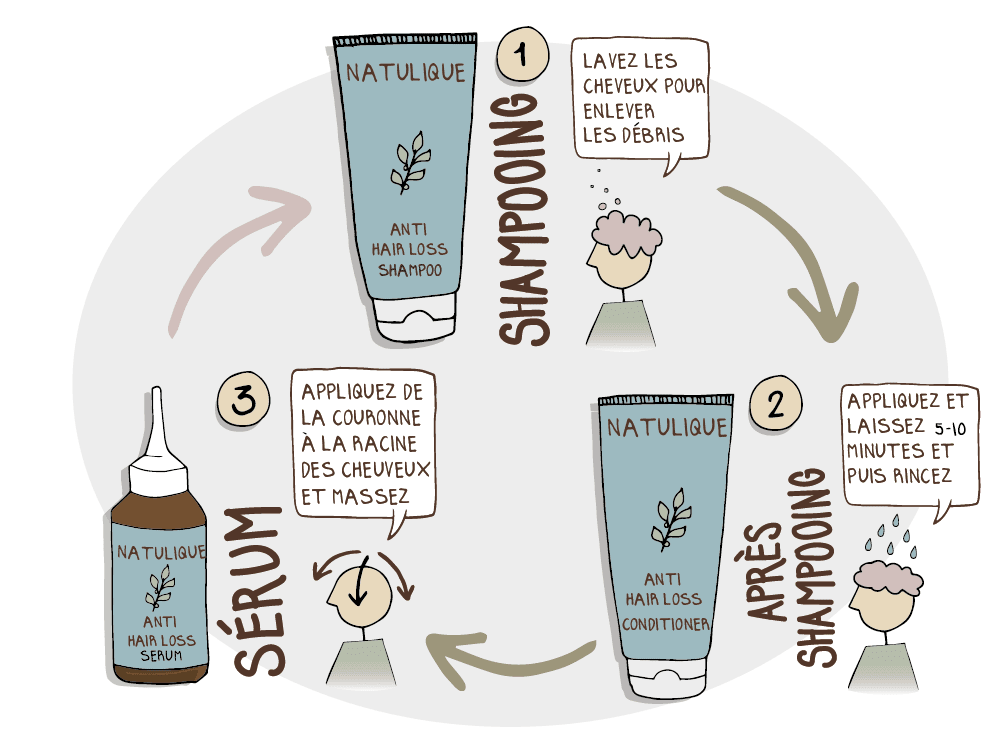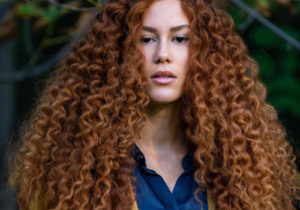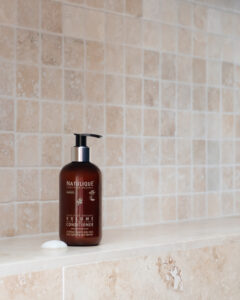Introduction to after-shampoo vinegar rinse
The principle of vinegar rinsing
The benefits of vinegar for hair
Vinegar is a natural solution widely used for hair care. Its acidic properties help rebalance the pH of the scalp, which is often altered by shampoos and hair care products. Vinegar is also excellent for removing chemical residues, leaving hair shiny and more manageable.
- Helps balance pH
- Removes hair product residues
- Makes hair shiny
- Makes detangling easier
Why use vinegar after shampooing?
Using vinegar after shampooing is a proven method for enjoying healthier hair. Shampoos can sometimes leave residues and deposits on the hair and scalp, which can cause irritation and various hair problems. Rinsing with vinegar can deep clean and improve hair texture.
- Deep cleansing
- Reduces scalp irritation
- Improves hair texture
The different types of vinegar you can use
Cider vinegar
Cider vinegar is one of the most popular choices for rinsing hair. It's rich in vitamins and minerals that nourish the hair and scalp. What's more, it has antibacterial and antifungal properties that help eliminate dandruff.
- Rich in vitamins and minerals
- Antibacterial and antifungal properties
- Helps eliminate dandruff
Rice vinegar
Rice vinegar is less well-known but just as effective. It is mainly used in Asia and is renowned for its moisturizing benefits. This type of vinegar is particularly recommended for dry, damaged hair, as it helps retain moisture and repair brittle hair.
- Moisturizes hair
- Recommended for dry, damaged hair
- Retains moisture and repairs brittle hair
White vinegar
More accessible and economical, white vinegar is an effective option for hair rinsing. Although it is more acidic than other types of vinegar, it is still very useful for removing product build-up and adding shine to hair. However, it must be used with care and diluted correctly to avoid irritating the scalp.
- Economical and accessible
- Eliminates product build-up
- Adds shine to hair

Preparing the vinegar rinse solution
Necessary ingredients
Choosing the right vinegar
The choice of vinegar is crucial for an effective hair rinse. Among the various options, cider vinegar is often recommended for its balancing and nourishing properties. Rice vinegar, meanwhile, is excellent for moisturizing dry, damaged hair. For those looking for a more economical option, white vinegar can also be used, although it requires a more substantial dilution.
- Cider vinegar: Balancing and nourishing properties
- Rice vinegar: Moisturizer for dry, damaged hair
- White vinegar: Economical, but requires correct dilution
The amount of water required
Diluting vinegar with water is an essential step to avoid scalp irritation and maximize benefits. In general, a ratio of 1:4 (one part vinegar to four parts water) is recommended. However, this ratio can be adjusted according to hair type and sensitivity. For example, a higher dilution may be necessary for very dry hair or a sensitive scalp.
- Normal hair: 1:4 ratio
- Dry or sensitive hair: Ratio 1:5 or more
- Greasy hair: 1:3 ratio
Preparation stages
Mixing vinegar and water
Preparing the vinegar rinse solution is simple, but must be done with care. Here are the steps to follow:
- Choose the right vinegar for your hair needs.
- Measure the quantity of vinegar and water according to the recommended ratio.
- Pour the vinegar into a clean container.
- Add the water to the vinegar and mix well to obtain a homogeneous solution.
This method ensures that the vinegar is diluted correctly, providing a gentle yet effective treatment for the hair.
Concentration adjustment according to hair type
Adjusting the concentration is a necessary step in tailoring the rinse solution to your hair's specific needs. Depending on your hair type and its specific problems, here are some tips for adjusting the concentration:
- Dry hair: Increase water quantity for gentler dilution
- Greasy hair: Increase the proportion of vinegar for a more astringent effect
- Colored hair: Use a medium dilution to preserve color while deep-cleaning.
By adjusting the concentration, you can maximize the benefits of the rinse solution while minimizing the risk of irritation or dryness.
Vinegar rinse application
How to apply the rinse solution
Correct application of the vinegar rinse solution is fundamental to achieving the best results. Here are the steps to follow:
- Wash your hair with a mild shampoo and rinse well.
- Pour the vinegar rinse solution gradually over your scalp and hair.
- Make sure the solution covers all the hair, massaging lightly into the scalp.
Massaging the scalp with the rinse solution helps stimulate blood circulation and maximize nutrient absorption.
Recommended exposure time
The application time of the vinegar rinse solution is also an important factor to consider. In general, it is recommended to let the solution sit on the hair for about 3-5 minutes. This allows the beneficial properties of the
See also: How to bleach hair naturally?
Vinegar rinse application
How to apply the rinse solution
Applying the solution to the hair
For best results with vinegar rinse solution, follow these steps:
- Wash your hair: Start by washing your hair with a mild shampoo. Be sure to rinse well to remove all shampoo residue.
- Prepare the solution: Have your vinegar rinse solution ready. Use a bottle with an applicator tip for easy application.
- Direct application: Pour the vinegar rinse solution gradually over your scalp and hair. Make sure you spread the solution evenly over the entire surface.
- Scalp massage: Gently massage the solution into your scalp in circular motions. This also stimulates blood circulation, promoting healthy hair.
Massaging the scalp helps relax the pores and maximize absorption of the nutrients in the vinegar.
Recommended exposure time
For the beneficial properties of the vinegar rinse solution to work effectively, it's essential to respect the correct application time. In general, we recommend leaving the solution on the hair for 3 to 5 minutes. This time allows the vinegar's mild acids to rebalance the scalp's pH and break down hair product residues.
- Normal hair: Application time 3-5 minutes for optimum effect.
- Very dry or damaged hair: Reduce application time to 2-3 minutes to avoid further drying.
- Greasy hair: You can leave the solution on for a little longer, up to 7 minutes, for a deep clean.
After the exposure time, decide whether or not you wish to rinse your hair.
Rinse or not after setting time
Do not rinse
Some prefer not to rinse the vinegar solution to maximize its benefits. Here are some considerations if you opt for this method:
- Long-lasting properties: Leaving the solution on your hair allows the acids in the vinegar to continue to balance the scalp's pH and maintain a healthy environment.
- Moisturizing effect: Vinegar can seal hair cuticles, helping to retain moisture and make hair smoother and shinier.
- Duration of effect: The beneficial effects can last longer, avoiding the frequent use of additional products.
Rinse
If you prefer to rinse your hair after the exposure time, follow these steps for optimal results:
- Use lukewarm water: Rinse your hair with warm water to remove excess vinegar while retaining some of its benefits.
- Avoid shampoos: Do not use shampoo after rinsing with vinegar, as this may cancel out the beneficial effects. If necessary, use a light conditioner.
- Gentle drying: Dry your hair with a microfiber towel to minimize friction and avoid further damage.
Additional tips
To optimize your hair care routine with vinegar rinse, consider the following tips:
- Frequency of use: Use the vinegar rinse once or twice a week, depending on your hair's needs.
- Avoid excess:</i

Care tips and FAQ about vinegar rinsing
Optimize your vinegar rinse routine
Frequency of use
It's important not to over-use vinegar rinses to preserve the natural balance of your hair and scalp. Once or twice a week is often enough to reap the benefits without causing over-irritation or dryness. If you notice your hair becoming too dry, reduce the frequency of use.
Integration with other hair care products
Vinegar rinses can be complemented by other natural hair care routines, such as moisturizing masks or essential oils. For example, jojoba, coconut or argan oils can be applied as a complement to improve your hair's health and shine.
Tips for different hair types
Each hair type may react differently to vinegar rinsing, so it's useful to adjust your routine to suit your specific needs. Here are a few tips:
- Curly hair: Curly hair can benefit from vinegar's detangling power and curl-defining effect.
- Fine hair: A lighter dilution can help prevent fine hair from becoming too flat or greasy.
- Colored hair: Use a light concentration to preserve color while keeping hair shiny.
FAQ
Can vinegar rinsing affect my hair color?
No, if used correctly and with proper dilution, vinegar rinse won't affect your hair color. In fact, it can help set color by closing hair cuticles.
Can I use a type of vinegar other than those mentioned?
Yes, you can use other types of vinegar, but it's advisable to start with vinegars known for their hair benefits, such as cider or rice vinegar. Always try a small amount to see how your hair reacts.
Can vinegar get rid of my dandruff?
Yes, cider vinegar in particular has antibacterial and antifungal properties that can help reduce dandruff. Regular use can improve the overall condition of your scalp.
Should I avoid rinsing with vinegar if I have a sensitive scalp?
If you have a sensitive scalp, try a stronger dilution (more water) and start with a low frequency of use to see how your scalp reacts. If irritation occurs, it's best to consult a dermatologist.
Can I prepare a large quantity of rinse solution in advance?
We recommend preparing the solution just before use to ensure freshness and effectiveness. If you prefer to prepare a larger quantity, store it in an airtight container in the fridge and use it within two weeks.
Conclusion
An after-shampoo vinegar rinse is a natural, economical and effective way to improve the health and appearance of your hair. Whether you choose cider, rice or white vinegar, each type offers specific benefits that can meet your particular hair needs. Adopt this hair care routine and enjoy shinier, healthier, more manageable hair.





